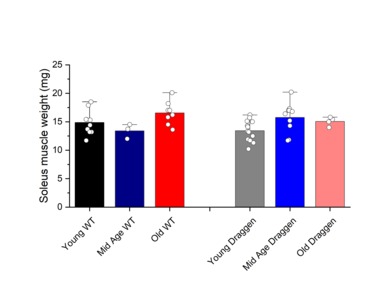Suetterlin, KJ;
Tan, SV;
Mannikko, R;
Phadke, R;
Orford, M;
Eaton, S;
Sayer, AA;
Grounds, MD;
Matthews, E;
Greensmith, L;
et al.
Suetterlin, KJ; Tan, SV; Mannikko, R; Phadke, R; Orford, M; Eaton, S; Sayer, AA; Grounds, MD; Matthews, E; Greensmith, L; Hanna, MG
(2021)
Ageing contributes to phenotype transition in a mouse model of periodic paralysis.
JCSM Rapid Communications, 4 (2).
pp. 245-259.
ISSN 2617-1619
https://doi.org/10.1002/rco2.41
SGUL Authors: Matthews, Emma Louise
|
PDF
Published Version
Available under License Creative Commons Attribution. Download (31MB) | Preview |
|
|
Archive (ZIP) (Figure S1)
Published Version
Available under License Creative Commons Attribution. Download (665kB) |
||
![[img]](https://openaccess.sgul.ac.uk/113830/9.hassmallThumbnailVersion/rco2_41-sup-0002-figure%20s2.png)
|
Image (PNG) (Figure S2)
Published Version
Available under License Creative Commons Attribution. Download (76kB) | Preview |
|
|
Microsoft Excel (Data S1)
Published Version
Available under License Creative Commons Attribution. Download (40kB) |
||
|
Microsoft Word (.docx)
Accepted Version
Available under License Creative Commons Attribution. Download (191kB) |
Abstract
Background Periodic paralysis (PP) is a rare genetic disorder in which ion channel mutation causes episodic paralysis in association with hyper- or hypokalaemia. An unexplained but consistent feature of PP is that a phenotype transition occurs around the age of 40, in which the severity of potassium-induced muscle weakness declines but onset of fixed, progressive weakness is reported. This phenotype transition coincides with the age at which muscle mass and optimal motor function start to decline in healthy individuals. We sought to determine if the phenotype transition in PP is linked to the normal ageing phenotype transition and to explore the mechanisms involved. Methods A mouse model of hyperkalaemic PP was compared with wild-type littermates across a range of ages (13–104 weeks). Only male mice were used as penetrance is incomplete in females. We adapted the muscle velocity recovery cycle technique from humans to examine murine muscle excitability in vivo. We then examined changes in potassium-induced weakness or caffeine contracture force with age using ex vivo muscle tension testing. Muscles were further characterized by either Western blot, histology or energy charge measurement. For normally distributed data, a student's t-test (± Welch correction) or one- or two-way analysis of variance (ANOVA) was performed to determine significance. For data that were not normally distributed, Welch rank test, Mann Whitney U test or Kruskal–Wallis ANOVA was performed. When an ANOVA was significant (P < 0.05), post hoc Tukey testing was used. Results Both WT (P = 0.009) and PP (P = 0.007) muscles exhibit increased resistance to potassium-induced weakness with age. Our data suggest that healthy-old muscle develops mechanisms to maintain force despite sarcolemmal depolarization and sodium channel inactivation. In contrast, reduced caffeine contracture force (P = 0.00005), skeletal muscle energy charge (P = 0.004) and structural core pathology (P = 0.005) were specific to Draggen muscle, indicating that they are caused, or at least accelerated by, chronic genetic ion channel dysfunction. Conclusions The phenotype transition with age is replicated in a mouse model of PP. Intrinsic muscle ageing protects against potassium-induced weakness in HyperPP mice. However, it also appears to accelerate impairment of sarcoplasmic reticulum calcium release, mitochondrial impairment and the development of core-like regions, suggesting acquired RyR1 dysfunction as the potential aetiology. This work provides a first description of mechanisms involved in phenotype transition with age in PP. It also demonstrates how studying phenotype transition with age in monogenic disease can yield novel insights into both disease physiology and the ageing process itself.
| Item Type: | Article | ||||||||||||
|---|---|---|---|---|---|---|---|---|---|---|---|---|---|
| Additional Information: | © 2021 The Authors. JCSM Rapid Communications published by John Wiley & Sons Ltd on behalf of Society on Sarcopenia, Cachexia and Wasting Disorders. This is an open access article under the terms of the Creative Commons Attribution License, which permits use, distribution and reproduction in any medium, provided the original work is properly cited. | ||||||||||||
| SGUL Research Institute / Research Centre: | Academic Structure > Molecular and Clinical Sciences Research Institute (MCS) | ||||||||||||
| Journal or Publication Title: | JCSM Rapid Communications | ||||||||||||
| ISSN: | 2617-1619 | ||||||||||||
| Language: | en | ||||||||||||
| Dates: |
|
||||||||||||
| Publisher License: | Creative Commons: Attribution 4.0 | ||||||||||||
| Projects: |
|
||||||||||||
| URI: | https://openaccess.sgul.ac.uk/id/eprint/113830 | ||||||||||||
| Publisher's version: | https://doi.org/10.1002/rco2.41 |
Statistics
Actions (login required)
 |
Edit Item |


